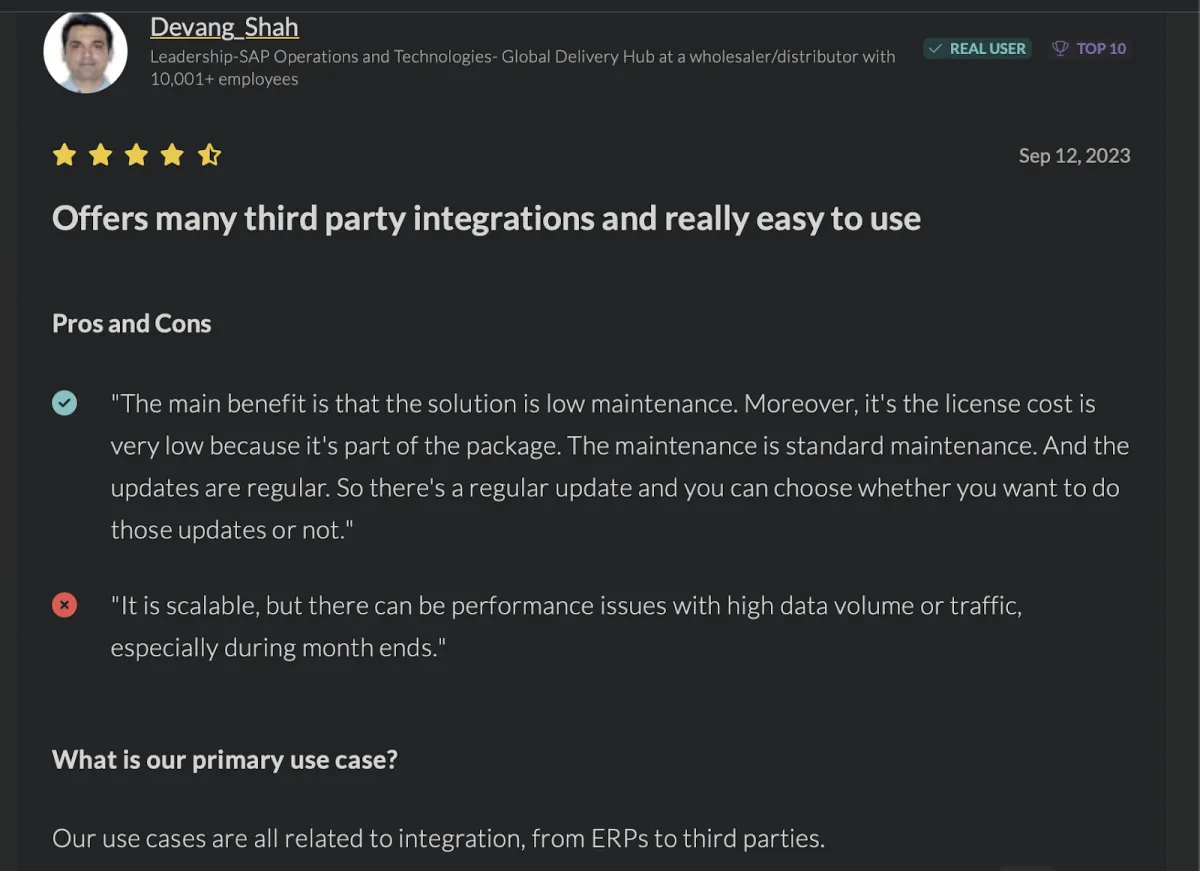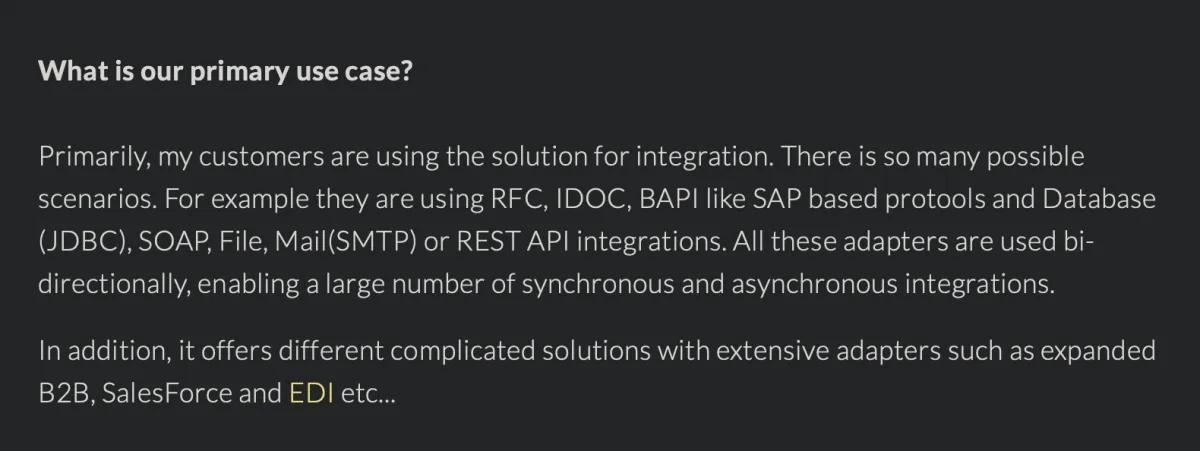We examine the core aspects of SAP PO, understanding its functionalities, benefits, and applications in the modern business landscape. See scalable software to assist SAP process orchestration and follow the links for the rationale behind our software selection:
- SAP Process Orchestration – Native SAP-centric integration and business process modeling
- RunMyJobs – Orchestrating SAP jobs while keeping a clean SAP core
- ActiveBatch – Hybrid cloud / API orchestration
- Stonebranch – Numerous community-driven pre-packaged integrations delivered as SaaS
- Fortra’s JAMS – PowerShell integration & job scheduling management on the .NET framework
- Tidal – Cost-effective workload automation
What is SAP PO?
SAP PO is a comprehensive software suite that facilitates the automation and integration of business processes across diverse systems and applications. It is part of the broader SAP NetWeaver platform and is often used by companies to streamline their IT landscapes by connecting different SAP and non-SAP systems. Organizations using SAP PO can achieve 3x faster message exchange and a 25% reduction in total cost of ownership.1
The primary components of SAP PO are:
SAP Business Rules Management (BRM): This enables the management of business rules separately from the application code. It provides flexibility by allowing business users to define and change rules without involving IT, which reduces the need for frequent code changes.
SAP Process Integration (PI): This allows different systems to communicate with each other via different communication protocols. It enables seamless data integration across both SAP and non-SAP applications.
SAP Business Process Management (BPM): This component allows businesses to model, execute, and monitor complex business processes that span across multiple applications and systems. It provides tools to design and automate workflows that involve human tasks, system tasks, and decision points.
Key Features of SAP PO
End-to-End Business Process Management
This feature allows for the creation, deployment, connection, monitoring, and adaptation of new business processes in a unified solution. It utilizes graphical business models and BPMN (Business Process Model and Notation) standards.
Support for Human and Automated Activities
It automatically generates end-user interfaces for detailed data viewing and associated activity performance. It also provides access, update, and reuse options for business functionality in automated activities.
SAP PO is praised for its low maintenance and low cost, but users also put forward their concerns regarding the performance issues with high data volume.

Source: Peerspot2
Cross-Application and Cross-Business Processes
SAP Process Orchestration supports both application-to-application (A2A) and business-to-business (B2B) integration through a single instance of middleware.
Decision Gateways and Business Rules
It enables the automation of decisions related to process or integration scenarios using business rules, which can be modified by business users once set up by IT.
Unified Solution for Business Process Orchestration
SAP PO helps model, implement, integrate, and monitor new processes, incorporating business rules into automated processes.
Process, Integration Scenario, and Rule Modeling
It aids collaboration between business and IT specialists in creating and adapting processes using the graphical BPMN standard.
Enterprise Service Bus with Preconfigured Services
SAP PO advertises and runs Web services in a service-oriented architecture, using a UDDI 3.0-compliant Web services directory.
10 use cases for SAP PO
Business Process Integration and Automation
SAP PO is frequently used to automate complex business processes, integrating various systems like ERP (e.g., SAP S/4HANA), CRM, and third-party applications to streamline workflows. This can involve automating purchase order processing, invoice management, or employee onboarding processes.

Source: Peerspot3
Data Synchronization
SAP PO can be utilized to synchronize data across different systems and platforms. This is particularly useful in scenarios where real-time data consistency is critical, such as inventory management or customer information updates across different channels.
Legacy System Integration
Many organizations use SAP PO to integrate legacy systems with modern applications. This allows them to leverage their existing IT investments while adopting new technologies and platforms.
B2B Communication
It supports business-to-business (B2B) communication, allowing companies to efficiently exchange data with external business partners. This includes EDI (Electronic Data Interchange) processes, where SAP PO helps in transforming and routing EDI messages between businesses.

Source: Peerspot
Process Monitoring and Analytics
By providing tools for monitoring and analyzing business processes, SAP PO helps organizations identify bottlenecks, inefficiencies, and opportunities for improvement in their workflows.
Cloud Integration
With the increasing adoption of cloud services, SAP PO is used to integrate on-premise systems with cloud-based applications and services, facilitating a hybrid cloud environment.
Custom Process Development
Organizations can use SAP PO to develop and implement custom processes tailored to their specific needs, which might not be covered by standard software solutions.
Compliance and Security
Ensuring data security and compliance with regulations (like GDPR) is another crucial use case, where SAP PO helps in enforcing data governance and security policies across integrated systems.
Scalable Workload Automation Solutions to assist SAP Process Orchestration
| Vendor | Rating* | SAP ECS Support |
|---|---|---|
| RunMyJobs by Redwood | 4.6 based on 150 reviews | ✅ |
| ActiveBatch | 4.6 based on 223 reviews | ❌ |
| Stonebranch | 4.8 based on 86 reviews | ❌ |
| Fortra’s JAMS | 4.5 based on 167 reviews | ❌ |
| Tidal | 4.7 based on 89 reviews | ❌ |
*Ratings are based on Capterra and G2.
Vendors are ranked according to their ratings except for vendors with links, who are sponsors of AIMultiple.
Third-party tools can complement the functionality of SAP PO by providing enhanced workflow management, job scheduling, and automation capabilities. By enabling more sophisticated integration and automation strategies across their IT landscapes, they can help organizations achieve a higher level of process efficiency and operational flexibility.
RunMyJobs by Redwood
RunMyJobs by Redwood is a cloud-based workload automation and job scheduling service offered as SaaS. RunMyJobs can manage workloads on S/4HANA or BTP through its ready-made integrations. This allows users to automate tasks without needing to install additional software or modify their core SAP systems.
RunMyJobs provides the highest number of integrations to SAP modules (e.g. SAP BusinessObjects, SAP BW, SAP CPI-DS, SAP Datasphere, SAP ERP S/4HANA, SAP IBP, SAP Industry Solutions, SAP Integration Suite). Additionally, RunMyJobs is the only non-SAP WLA solution that is included in the SAP ECS team’s list of supported applications which makes it one of the better choices for SAP PO.
Follow the link for key takeaways regarding RunMyJobs and SAP, as it remains one of the strongest choices for SAP environments.
ActiveBatch
ActiveBatch is a workload automation and job scheduling software that supports a wide range of applications, databases, and platforms. It offers a visual workflow designer, which allows users to create and manage complex workflows. ActiveBatch can integrate with SAP systems, including SAP PO, to automate SAP processes and tasks, enhancing efficiency and reducing manual intervention.
ActiveBatch includes a versatile API creation tool known as the Super REST API adapter. This module enables the use of AWS signature authentication for making AWS API calls with the signature, while also allowing the mapping of JSON responses to return variables.
Stonebranch Universal Automation Center (UAC)
Stonebranch UAC is an IT orchestration and automation platform designed to manage workflows across complex hybrid IT environments. It supports integration with SAP and other enterprise applications, enabling organizations to automate and orchestrate tasks across different systems. Moreover, UAC has a community-backed open source, Stonebranch Integration Hub, that users can use. UAC’s capabilities can be leveraged to optimize SAP PO processes.
Check out Stonebranch for more detailed information on its key features and user insights.
Fortra’s JAMS
Fortra’s JAMS is a job scheduling and workload automation solution that enables organizations to centralize and manage their batch processing across different platforms and applications. JAMS provides integration capabilities with SAP, allowing for the automation of SAP jobs and tasks within a unified workflow.
Tidal Workload Automation
Tidal Workload Automation is an enterprise-grade automation platform designed to manage, automate, and orchestrate complex workflows across multiple applications and systems. It offers scheduling capabilities and extensive pre-built integrations. Tidal can integrate with SAP systems, including SAP PO, to automate SAP-related processes and tasks, ensuring they are executed in alignment with the broader enterprise workflow.
What is the Difference Between SAP BTP and SAP PO?
SAP Process Orchestration (SAP PO) is an on-premise middleware tool used primarily for integrating SAP and non-SAP systems and automating business processes. It manages workflows, orchestrates services, and handles application-to-application (A2A) and business-to-business (B2B) integration within a controlled on-premise environment. SAP PO best suits organizations with traditional IT landscapes seeking robust integration and process automation solutions.
SAP Business Technology Platform (SAP BTP), on the other hand, is a cloud-based platform offering a wide range of services for integration, application development, data management, analytics, artificial intelligence, and more. It enables organizations to modernize their IT infrastructures, leverage cloud technologies, and build or extend applications in a scalable, flexible environment. While SAP PO focuses on process orchestration, SAP BTP is geared toward digital transformation and innovation, encompassing a broader scope of cloud-native capabilities.
Further Reading
- Top SAP Workload Automation Software & Use Cases
- Top RPA SAP Use Cases & Examples
- Redwood-SAP Partnership: Clean Core Support for SAP Customers

Comments
Your email address will not be published. All fields are required.